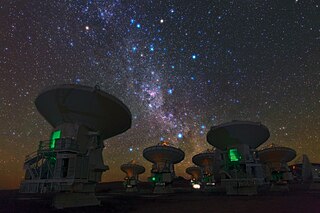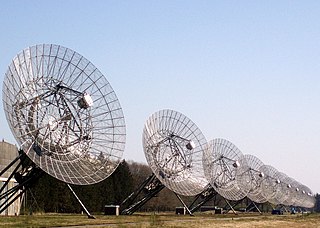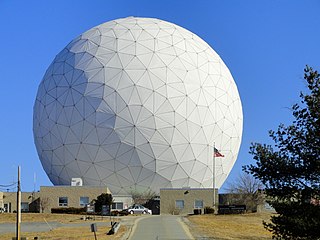
A radio telescope is a specialized antenna and radio receiver used to detect radio waves from astronomical radio sources in the sky. Radio telescopes are the main observing instrument used in radio astronomy, which studies the radio frequency portion of the electromagnetic spectrum emitted by astronomical objects, just as optical telescopes are the main observing instrument used in traditional optical astronomy which studies the light wave portion of the spectrum coming from astronomical objects. Unlike optical telescopes, radio telescopes can be used in the daytime as well as at night.

Very-long-baseline interferometry (VLBI) is a type of astronomical interferometry used in radio astronomy. In VLBI a signal from an astronomical radio source, such as a quasar, is collected at multiple radio telescopes on Earth or in space. The distance between the radio telescopes is then calculated using the time difference between the arrivals of the radio signal at different telescopes. This allows observations of an object that are made simultaneously by many radio telescopes to be combined, emulating a telescope with a size equal to the maximum separation between the telescopes.

The Karl G. Jansky Very Large Array (VLA) is a centimeter-wavelength radio astronomy observatory in the southwestern United States. It lies in central New Mexico on the Plains of San Agustin, between the towns of Magdalena and Datil, approximately 50 miles (80 km) west of Socorro. The VLA comprises twenty-eight 25-meter radio telescopes deployed in a Y-shaped array and all the equipment, instrumentation, and computing power to function as an interferometer. Each of the massive telescopes is mounted on double parallel railroad tracks, so the radius and density of the array can be transformed to adjust the balance between its angular resolution and its surface brightness sensitivity. Astronomers using the VLA have made key observations of black holes and protoplanetary disks around young stars, discovered magnetic filaments and traced complex gas motions at the Milky Way's center, probed the Universe's cosmological parameters, and provided new knowledge about the physical mechanisms that produce radio emission.

The National Radio Astronomy Observatory (NRAO) is a federally funded research and development center of the United States National Science Foundation operated under cooperative agreement by Associated Universities, Inc. for the purpose of radio astronomy. NRAO designs, builds, and operates its own high-sensitivity radio telescopes for use by scientists around the world.

The Robert C. Byrd Green Bank Telescope (GBT) in Green Bank, West Virginia, US is the world's largest fully steerable radio telescope, surpassing the Effelsberg 100-m Radio Telescope in Germany. The Green Bank site was part of the National Radio Astronomy Observatory (NRAO) until September 30, 2016. Since October 1, 2016, the telescope has been operated by the independent Green Bank Observatory. The telescope's name honors the late Senator Robert C. Byrd who represented West Virginia and who pushed the funding of the telescope through Congress.

The Very Long Baseline Array (VLBA) is a system of ten radio telescopes which are operated remotely from their Array Operations Center located in Socorro, New Mexico, as a part of the National Radio Astronomy Observatory (NRAO). These ten radio antennas work together as an array that forms the longest system in the world that uses very long baseline interferometry. The longest baseline available in this interferometer is about 8,611 kilometers (5,351 mi).

The Multi-Element Radio Linked Interferometer Network (MERLIN) is an interferometer array of radio telescopes spread across England. The array is run from Jodrell Bank Observatory in Cheshire by the University of Manchester on behalf of UK Research and Innovation.

The Submillimeter Array (SMA) consists of eight 6-meter (20 ft) diameter radio telescopes arranged as an interferometer for submillimeter wavelength observations. It is the first purpose-built submillimeter interferometer, constructed after successful interferometry experiments using the pre-existing 15-meter (49 ft) James Clerk Maxwell Telescope and 10.4-meter (34.1 ft) Caltech Submillimeter Observatory as an interferometer. All three of these observatories are located at Mauna Kea Observatory on Mauna Kea, Hawaii, and have been operated together as a ten element interferometer in the 230 and 345 GHz bands. The baseline lengths presently in use range from 16 to 508 meters. The radio frequencies accessible to this telescope range from 194–408 gigahertz (1.545–0.735 mm) which includes rotational transitions of dozens of molecular species as well as continuum emission from interstellar dust grains. Although the array is capable of operating both day and night, most of the observations take place at nighttime when the atmospheric phase stability is best.

The Ryle Telescope was a linear east-west radio telescope array at the Mullard Radio Astronomy Observatory. In 2004, three of the telescopes were moved to create a compact two-dimensional array of telescopes at the east end of the interferometer. The eight antennas have now become the Arcminute Microkelvin Imager Large Array.

The Westerbork Synthesis Radio Telescope (WSRT) is an aperture synthesis interferometer built on the site of the former World War II Nazi detention and transit camp Westerbork, north of the village of Westerbork, Midden-Drenthe, in the northeastern Netherlands.

The European VLBI Network (EVN) is a network of radio telescopes located primarily in Europe and Asia, with additional antennas in South Africa and Puerto Rico, which performs very high angular resolution observations of cosmic radio sources using very-long-baseline interferometry (VLBI). The EVN is the most sensitive VLBI array in the world, and the only one capable of real-time observations. The Joint Institute for VLBI ERIC (JIVE) acts as the central organisation in the EVN, providing both scientific user support and a correlator facility. Very Long Baseline Interferometry (VLBI) achieves ultra-high angular resolution and is a multi-disciplinary technique used in astronomy, geodesy and astrometry.

Haystack Observatory is a multidisciplinary radio science center, ionospheric observatory, and astronomical microwave observatory owned by Massachusetts Institute of Technology (MIT). It is in Westford, Massachusetts, in the United States, about 45 kilometers (28 mi) northwest of Boston. The observatory was built by MIT's Lincoln Laboratory for the United States Air Force and was called the Haystack Microwave Research Facility. Construction began in 1960, and the antenna began operating in 1964. In 1970 the facility was transferred to MIT, which then formed the Northeast Radio Observatory Corporation (NEROC) with other universities to operate the site as the Haystack Observatory. As of January 2012, a total of nine institutions participated in NEROC.

The Institute of Astronomy of Nicolaus Copernicus University in Toruń, known prior to 1 October 2019 in scientific publications as the Toruń Centre for Astronomy, is an optical and radio observatory located at in Piwnice, about 15 km north of Toruń, Poland. It houses two single-dish antenna telescopes, 32 metres and 15 metres in diameter, as well as the largest Polish optical telescope – 90 cm Schmidt-Cassegrain camera. The facility is operated by the Nicolaus Copernicus University. Also, photometry using 60 cm Cassegrain telescope is made and radio measurements of the Sun at 127 MHz frequency have been recorded on a daily basis since 1958 using a 23 m interferometer.

The Mark II is a radio telescope located at Jodrell Bank Observatory, near Goostrey, Cheshire, in the north-west of England. It was built on the site of the 218 ft (66.4 m) Transit Telescope. Construction was completed in 1964. The telescope's design was used as the basis of the 85 ft (26 m) Goonhilly 1 dish, and the Mark III telescope is also based on a similar design.

The Warkworth 12m Radio Telescope is a radio telescope at the Warkworth Radio Astronomical Observatory, located just south of Warkworth, New Zealand, about 50 km north of the Auckland CBD. It is operated by the Institute of Radio Astronomy and Space Research of Auckland University of Technology and was constructed in 2008.

The OVRO 40 meter Telescope is a radio telescope at the Owens Valley Radio Observatory near Big Pine, California, US. It is owned and operated by Caltech. The telescope is easily visible from the section of US highway 395 just north of Big Pine.

The Korean VLBI Network (KVN) is a radio astronomy observatory located in South Korea. It comprises three 21-meter radio telescopes that function as an interferometer, using the technique of very-long-baseline interferometry (VLBI).

The Green Bank Observatory is an astronomical observatory located in the National Radio Quiet Zone in Green Bank, West Virginia, U.S. It is the operator of the Robert C. Byrd Green Bank Telescope, the world's largest fully steerable radio telescope.

Barry Gillespie Clark is an American astronomer who led the development of the world's first digitally recorded, software correlated Very Long Baseline Interferometry (VLBI) system for radio astronomy, the Green Bank Interferometer. He was also heavily involved in the development of the Very Large Array and the Very Long Baseline Array.

The 40-foot radio telescope at Green Bank Observatory in the U.S. state of West Virginia was constructed in 1961, and started observing a selection of variable radio sources in the same year, completing its observations in 1968. It became the first automated telescope in 1962. It was subsequently used during summer schools, and in 1987 it was repurposed as an educational telescope, as well as continuing to observe radio sources. In 2021 the telescope celebrated its sixtieth anniversary, having been in continuous use since its 1987 restoration, and used by more than 1,500 students.























